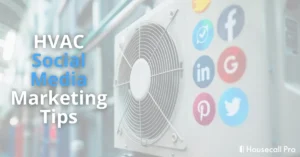Want to win more jobs with less effort?
Grow your business and send quick quotes with our home service software.

Want to see your potential revenue?
See what businesses like yours earn with Housecall Pro in 1 - 2 minutes.

HVAC training can be a smart investment, but it’s not cheap. Trade school alone can cost over $10,000, and that doesn’t include tools, exam fees, or licensing. For aspiring techs and business owners alike, these costs play a big role in planning and long-term success. But with the right training path and some strategic budgeting, that investment can lead to steady work, strong earnings, and room to grow in a high-demand industry.
In this article, we’ll explore what HVAC schooling really costs, the different paths available, and some practical ways to save money along the way.
Types of HVAC training
Not all HVAC programs are the same. The path you choose can significantly affect your upfront costs, timeline, and certification options.
Training is typically offered through trade schools, community colleges, union-sponsored apprenticeship programs, manufacturer-sponsored training centers, and online or hybrid programs. Each route comes with pros and cons. For example, trade schools and community colleges offer more formal education and certification opportunities, but can be costly.
Apprenticeship programs are much more affordable and often include paid, hands-on experience, but take longer to complete. Meanwhile, fast-track and online programs offer flexibility and speed but may lack the hands-on experience of traditional paths, which could make you less competitive in the job market.
When choosing a path, it’s important to consider not only the cost and duration, but also how employers in your area view each option. Here are the most common HVAC training types, how long they take to complete, and their average costs.
| Type of Training | Duration | Cost Range* |
| Certificate Program | 6–12 months | $1,200–$15,000 |
| Associate Degree | 18–24 months | $15,000–$35,000 |
| Apprenticeship | 3–5 years | $500–$2,000 |
| Accelerated/Fast-Track | Varies (6–12 months) | $1,200–$15,000 |
| Online/Hybrid Programs | ~12 months | $3,000–$5,000 |
*Costs according to the New England Institute of Technology and our direct analysis of HVAC schools.
Certificate and trade school programs
Certificate programs and trade schools are a popular starting point for those entering the HVAC industry. These programs typically last between 6 and 12 months and combine classroom instruction with hands-on training in areas like refrigeration, electrical systems, heating, and air conditioning. Graduates are often well-prepared to take certification exams such as the EPA 608 or NATE.
One reason many people choose this route is the relatively short timeline. It’s possible to go from zero experience to job-ready in under a year. These programs are widely available through community colleges, technical schools, and private institutions.
The cost of these programs can vary significantly. Public schools tend to be more affordable, especially for in-state students, with costs ranging from $1,200 to $5,000. Private institutions or out-of-state tuition can run higher, up to $15,000 or more. Upon completion, students are equipped for entry-level technician roles with room to grow.
Some programs include exam prep or toolkits in the tuition, so be sure to ask when comparing schools.
Pros:
- Shorter time to workforce
- Lower upfront costs (especially at public institutions)
- Focused, HVAC-specific training
Cons:
- Fewer general education courses
- May not be as in-depth as longer programs
- Some employers may prefer candidates with more comprehensive training
Associate degree programs
Depending on where you live and where you want to work, some employers may look for candidates with an associate’s degree. These two-year HVAC training programs combine technical instruction with general education courses, offering a broader foundation than certificate programs. You’ll still get hands-on training in HVAC systems, but you’ll also study math, writing, and business basics. These skills can serve you well if you decide to pursue a business degree later on or eventually start your own HVAC company.
Associate degrees are available through community colleges and some technical schools. The HVAC school cost varies: Public two-year colleges average about $11,600 per year for full-time students, including room and board. Private nonprofit colleges can reach $30,850 annually, while private for-profit options average around $24,300.
Though more expensive than a certificate, an associate degree may provide a stronger return over time—especially for those interested in leadership, entrepreneurship, or project management.
Pros:
- Broader education including math, writing, and business
- May lead to higher earning potential
- Can create a stronger foundation for future business ownership or career advancement
Cons:
- More expensive than certificate programs
- Takes longer to complete
- May include less hands-on training, depending on the program
Apprenticeships
Apprenticeships offer a hands-on path into the HVAC field—and unlike most schooling options, you get paid to learn. These programs, often run by unions, contractor associations, or state workforce programs, typically last three to five years and combine on-the-job training with classroom instruction. Apprentices work under experienced technicians, gaining practical experience while learning essential HVAC skills like system diagnostics, installation, and repair.
While most apprenticeships are paid, there may be small registration or program fees ranging from $500 to $2,000. However, the income helps offset these costs. First-year apprentices can expect to earn around $15 to $18 per hour, with wages increasing as skills develop.
To qualify, applicants typically must meet the following requirements:
- Be 18 years old or older
- Hold a high school diploma or equivalent credential (such as a GED)
- Have a valid driver’s license
- Pass a drug test
- Be capable of working in a physically demanding environment
Apprenticeships are a great option for those who prefer learning by doing and want to earn while they train.
Pros:
- Earn while you learn
- Extensive hands-on experience under real-world conditions
- Strong job readiness upon program completion
Cons:
- Longer time commitment
- Limited availability and competitive application process
- Must meet eligibility requirements
Accelerated/fast-track programs
Accelerated or fast-track HVAC training programs are designed to get students job-ready in a short amount of time, often in six months or less. Many HVAC schools across the U.S. offer these condensed programs, with completion in as few as four months.
These programs focus almost entirely on core HVAC topics, skipping general education courses. Students dive right into subjects like refrigeration, electrical systems, and equipment diagnostics, often combining classroom learning with hands-on training. However, make sure to consider whether the condensed format offers enough depth for your career goals.
The cost of fast-track programs varies but can start as low as $1,200. Public institutions tend to be more affordable, while private schools may charge more.
Pros:
- Shorter time to workforce
- Lower upfront costs
- Focused, HVAC-specific training
Cons:
- Fewer general education courses
- May not be as in-depth as longer programs
- Some employers may prefer candidates with more comprehensive training
Online and Hybrid HVAC Programs
Online and hybrid HVAC programs have become increasingly popular as more students seek flexible learning options. These programs typically include lectures, readings, and assessments online, while some also include scheduled in-person labs or hands-on workshops.
The structure varies by program, but most cover key HVAC topics such as system components, diagnostics, safety protocols, and prep for EPA certification exams. Programs can often be completed in about 12 months, with costs ranging from $3,000 to $5,000.
While some fully virtual programs offer certificates like the EPA 608 or NATE Ready to Work, others require in-person components to meet certification standards. Always verify whether the program you choose qualifies for local licensing or job requirements.
Pros:
- Flexible schedule
- Learn at your own pace
- Accessible from anywhere
Cons:
- Limited hands-on experience
- May lack direct instructor feedback
- In-person training may still be required
What does HVAC training cost include?
You’ll need to budget for more than just tuition. HVAC training can also include costs for tools, textbooks, and exam fees. Here’s what you can expect your total training cost to include.
Tuition and fees
HVAC tuition varies widely depending on the type of program. Certificate programs range from $1,200 to $15,000, associate degrees from $15,000 to $35,000, and online/hybrid options usually fall between $3,000 and $5,000. In-state students at public schools typically pay less than out-of-state students. If you attend school away from home, be sure to factor in housing and meal plan costs, which can add $8,000 to $12,000 per year to your total expenses.
Tools, textbooks, and materials
Additional materials like textbooks, lab fees, safety gear, and toolkits can cost between $500 and $2,000. Some schools provide basic tools for classroom use, but many programs eventually require students to buy their own. Common tools include gauges, multimeters, screwdrivers, pipe cutters, and wrenches. Employers may supply tools for new hires, but having your own set is often encouraged or expected once on the job.
Certification and exam fees
HVAC certification programs often come with added costs for exams and credentials. Here’s what you need to know before signing up.
EPA 608
The EPA 608 certification is required for any technician working with refrigerants. It includes four types: Type I (small appliances), Type II (high-pressure systems), Type III (low-pressure systems), and Universal (covers all three). Exams typically cost $20–$60 each, or around $100 for the Universal exam. There’s no expiration, but if you fail, you’ll need to retake it.
NATE
The NATE certification is a nationally recognized credential that confirms HVAC expertise. The cost is usually around $150 for the initial core exam and $150 for each specialty exam. Certification is valid for two years and requires retesting or continuing education credits for renewal. It’s voluntary but valued by employers.
State Licensing
Many states require HVAC technicians to be licensed, particularly for work involving electrical or plumbing components. Fees vary, but you can expect to pay between $50 and $300 for application and testing. For example, the license application is $115 in Texas. Most licenses must be renewed every 1 to 2 years, often with proof of continuing education.
How to pay for HVAC schooling
HVAC school costs can feel overwhelming, but there are several ways to manage expenses and reduce your overall spending.
Scholarships, loans, and grants
Students enrolled in accredited HVAC certification programs may qualify for federal aid, such as Pell Grants and federal student loans. Many schools also offer their own scholarships or financial aid packages. Private scholarships are available through trade associations and nonprofit groups, so it’s worth applying broadly.
Housecall Pro also provides financial support for aspiring HVAC professionals through Trade Academy, which offers scholarships, training cost assistance, and free access to career resources and a job board.
Employer sponsorships
Some HVAC employers offer tuition reimbursement or will sponsor your training in exchange for a work commitment. This can be a great way to gain both funding and job security after graduation.
GI Bill and workforce programs
Veterans may be eligible to use GI Bill benefits to cover tuition and other school-related costs. State and local workforce development programs also offer grants and support for low-income individuals pursuing careers in the trades, including HVAC.
Training cost by region and institution
HVAC training costs vary not just by location but also by the type of school. Public community colleges are generally more affordable than private trade schools, especially for in-state students. For example, according to the New England Institute of Technology:
- Connecticut’s in-state tuition is about $2,380 compared to $13,270 for out-of-state.
- New York averages $5,390 in-state and $9,430 out-of-state.
- California is among the lowest at $1,310 in-state, while out-of-state is $7,730.
Remember to factor in living expenses, which can significantly impact your overall costs.
Return on investment for HVAC training
Given the time and money required to become an HVAC technician, you want to make sure you’re getting a good return on your investment. According to the Bureau of Labor Statistics, the median HVAC technician salary is $59,810 per year, meaning many technicians can recoup their education costs in a relatively short amount of time. Apprenticeships allow you to earn while learning, minimizing or eliminating student debt altogether.
With experience and specialization, your salary can climb into six figures—especially if you decide to open your own HVAC business. Demand is also on the rise, especially in states with extreme climates. Your location, certifications, and training path all influence how quickly you’ll see a return on your investment.
Tips to reduce HVAC education costs
HVAC training costs can vary widely depending on the type of training you choose. While it’s tempting to take the fastest or most convenient route, make sure you understand what local employers are looking for and which certifications they expect. The path you choose can directly impact your job prospects, starting salary, and long-term earning potential.
Here are a few ways to save money:
- Attend community college to take advantage of lower in-state tuition rates.
- Buy used tools from reputable sellers, schools, or second-year students.
- Apply for scholarships early to increase your chances of getting financial aid.
- Compare local apprenticeship opportunities that offer paid, hands-on experience.
- Use HVAC apps and online tools like the HVAC School app to reinforce skills, prep for exams, and avoid extra courses or study delays.
Get In Touch: 858-842-5746
Let us earn your trust
On average, Pros increase monthly revenue generated through Housecall Pro by 50% after their first year.
See plan options and feature breakdown on our pricing page.
How Housecall Pro supports HVAC pros
Whether you’re just starting your HVAC career or looking to grow your skills, Housecall Pro is here to support every step of your journey. From free guides and training resources to business tips tailored to HVAC techs, we’re committed to helping you succeed. We also partner with scholarship programs and trade education initiatives to make HVAC careers more accessible and affordable.
FAQ
-
How long does HVAC training take?
-
HVAC training can take anywhere from four months to five years, depending on the program type—certificate, associate degree, or apprenticeship.
-
Do you need a degree to become an HVAC tech?
-
In most cases, you don’t need a degree to become an HVAC tech. Many people start with a certificate or apprenticeship and earn certifications instead of a college degree. Be sure to check with employers in your area to better understand their specific requirements.
-
What certifications do you need after HVAC training?
-
Most HVAC techs need EPA 608 certification. NATE and other specialized certifications are also valuable, depending on your job goals and local requirements.
-
Can you start working while still in HVAC school?
-
Yes, many students work part-time in entry-level roles or apprenticeships while completing HVAC training.
-
What’s the cheapest way to get HVAC-certified?
-
Apprenticeships are often the cheapest way to get HVAC-certified. They’re usually low-cost and offer paid on-the-job training while you learn.






